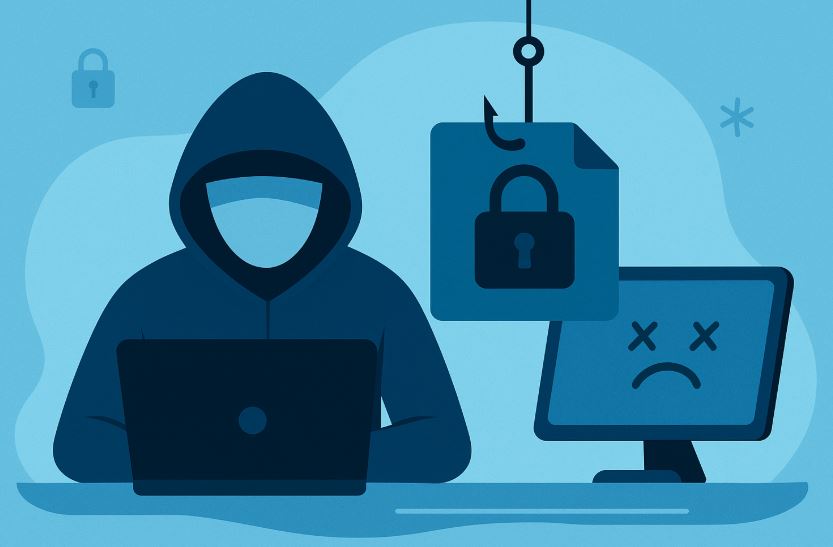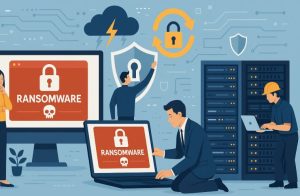
How Can Ransomware Be Defined in Cyber Security?
What happens when the files and systems a business relies on every day suddenly become inaccessible, with a threatening message demanding payment in exchange for their return? This is not a scene from a film but a harsh reality for thousands of organisations worldwide.
The answer lies in a form of malware known as ransomware, one of the most destructive threats in modern cyber security.
Ransomware is malicious software that encrypts a victim’s files or locks their system, preventing normal access. Attackers then demand a ransom, commonly in cryptocurrency, for the decryption key or to stop sensitive information from being published.
Unlike traditional malware, which often aims to steal data quietly, ransomware thrives on visibility. Victims are made fully aware of the attack through ransom notes that appear across screens and files.
Key attributes of ransomware include the use of strong cryptographic methods, anonymous payment methods such as Bitcoin, and increasingly sophisticated extortion techniques.
What makes ransomware particularly devastating is its dual impact: not only is data made inaccessible, but there is also the added risk of reputational damage, financial loss, and regulatory scrutiny.
How Do Ransomware Attacks Work?

Although ransomware comes in many forms, the core mechanics of an attack generally follow a staged process. Understanding these stages is vital for any organisation preparing a defence strategy.
The first step is infection. This is often achieved through phishing emails, where an unsuspecting employee opens a malicious attachment or clicks on a harmful link.
Other common routes include exploiting weaknesses in Remote Desktop Protocol (RDP), taking advantage of unpatched software vulnerabilities, or infiltrating supply chains by compromising third-party vendors.
Recent years have seen a sharp increase in supply chain ransomware, where attackers bypass direct defences by infiltrating partners or contractors.
Once inside the system, the ransomware moves to execution and encryption. It scans files, selects high-value targets, and begins encrypting them using advanced algorithms.
Many strains are programmed to delete backup and shadow copies to ensure recovery is almost impossible without the decryption key. Some also lock users out of entire operating systems, creating total paralysis.
The next stage is the ransom demand. Attackers deliver instructions to the victim, often through on-screen pop-ups, desktop notes, or text files placed in each folder.
Victims are told how much to pay, where to send the cryptocurrency, and how to contact the attackers. In modern strains, double or triple extortion is common, data is not only encrypted but also stolen, with threats of leaking it to the public or selling it if payment is refused.
The final element is extortion and outcome. Some victims pay and receive a working decryption key. Others pay but never regain access, as there is no guarantee that cybercriminals will honour their word. Many organisations that pay the ransom become repeat targets, as attackers recognise them as vulnerable.
The following table illustrates the common stages of a ransomware attack:
| Stage | Description | Example Techniques |
| Infection | Malware infiltrates through phishing, RDP, supply chain, or vulnerabilities | Phishing emails, compromised credentials |
| Execution | Malware installs and begins to scan and spread | Exploit kits, malware loaders |
| Encryption | Data is scrambled and shadow copies deleted | AES/RSA encryption methods |
| Ransom Demand | Victims receive payment instructions | Desktop ransom notes, TOR payment sites |
| Extortion | Attackers threaten permanent loss or data leaks | Double/triple extortion strategies |
Why Are Ransomware Attacks Increasing Globally?
The global surge in ransomware is not accidental but the result of several interrelated factors. The landmark moment was the WannaCry outbreak in 2017, which spread rapidly across 150 countries and crippled major organisations, including healthcare providers and government institutions. This attack highlighted the profitability of ransomware and inspired countless imitators.
The COVID-19 pandemic further intensified the problem. As organisations shifted to remote working at speed, they created gaps in cyber defences.
VPN misconfigurations, poorly secured home networks, and increased use of personal devices expanded the attack surface. Cybercriminals exploited these vulnerabilities aggressively, launching targeted campaigns at industries such as healthcare, education, and finance.
Statistics reveal the scale of the problem. Research indicates that 71 per cent of businesses have faced ransomware attacks, with average incident costs of over $4 million.
The rate of attempted ransomware attacks rose from 7 per cent of organisations in 2022 to 10 per cent in 2023, the highest level recorded. By 2025, attackers increasingly exploited suppliers and service providers as indirect entry points, bypassing direct corporate defences altogether.
What Are the Different Types of Ransomware Attacks?

Ransomware has evolved from simple file lockers into highly complex and adaptive threats. Among the most common are crypto ransomware, which encrypts files; and locker ransomware, which blocks access to entire devices.
More advanced methods include double extortion, where attackers both encrypt and steal data, threatening to release it unless payment is made.
Some groups have escalated to triple extortion, in which victims’ customers, suppliers, or even the wider public are targeted, often through distributed denial-of-service (DDoS) attacks.
There are also wipers, malicious programs disguised as ransomware but designed to permanently destroy data.
Another growing trend is Ransomware-as-a-Service (RaaS), where ransomware developers sell or lease their software to affiliates, significantly lowering the barrier to entry for cybercrime.
Finally, some ransomware families focus solely on data theft, abandoning encryption altogether in favour of faster, stealthier attacks.
Which Ransomware Variants Have Made the Biggest Impact?
Over the past decade, several ransomware families and groups have gained notoriety for their scale and sophistication.
- RansomHub, active in 2024 and early 2025, rose rapidly by attracting affiliates with generous profit-sharing. Known for fast encryption and remote targeting, it shut down in April 2025, with affiliates moving to groups like Qilin.
- Akira, discovered in 2023, targets both Windows and Linux systems, often using VPN flaws. It uses intermittent encryption to evade detection and focuses on large enterprises.
- Play, also known as Playcrypt, has compromised hundreds of organisations globally, using intermittent encryption and double extortion.
- Cl0p has gained attention for exploiting zero-day vulnerabilities and targeting industries like healthcare and finance.
- Qilin, prominent in 2025, employs highly customisable ransomware and operates a dark web data leak site.
- Ryuk is infamous for multimillion-dollar ransom demands, focusing on large organisations.
- Maze pioneered the double extortion model, combining file encryption with data theft.
- REvil (Sodinokibi) is responsible for several high-profile breaches, including Kaseya.
- LockBit, operating since 2019, is known for rapid, automated encryption.
- DearCry targeted Microsoft Exchange servers in 2021.
- Lapsus$ is an extortion group famous for attacking major tech companies such as Nvidia and Samsung.
Each of these groups demonstrates the evolving nature of ransomware, from rapid encryption to complex extortion methods.
How Do Ransomware Attacks Affect Businesses?

The consequences of ransomware can be catastrophic. One of the most immediate impacts is business disruption. Organisations lose access to vital systems and data, halting operations for hours, days, or even weeks. For sectors like healthcare or utilities, this can put lives at risk.
There is also data loss, particularly when backups are destroyed or deleted. Even when a ransom is paid, recovery is not guaranteed, and some data may be permanently inaccessible.
The financial impact is multifaceted. Beyond the ransom itself, costs include downtime, IT recovery, lost business, legal expenses, and potential fines from regulators.
Global studies place the average cost of a ransomware incident at over $4 million, but for large enterprises the figure can be much higher.
A further effect is reputational damage. Customers, partners, and stakeholders may lose confidence in an organisation’s ability to protect sensitive information. For some businesses, this damage is more long-lasting than the technical disruption itself.
Finally, ransomware attacks can lead to legal and regulatory consequences, especially in sectors handling sensitive data such as healthcare, finance, or government. Failure to adequately protect personal information may result in penalties under frameworks such as GDPR.
What Are the Common Ransomware Distribution Techniques?
Ransomware is distributed through several primary methods. Phishing emails remain the most common, often disguised as legitimate communication to trick recipients into downloading malicious attachments or clicking unsafe links. Email attachments containing macros or compressed files with embedded scripts are particularly effective for attackers.
Social media platforms and instant messaging applications are also exploited, with malicious links spreading rapidly among users. Malvertising, the injection of malicious code into online adverts, can compromise even reputable websites.
Drive-by downloads occur when users visit compromised web pages, where malware is automatically downloaded without their knowledge.
Attackers also use traffic distribution systems (TDS), which redirect users to malicious websites based on their location or system setup. Some ransomware families are capable of self-propagation, spreading through networks and removable drives to infect as many systems as possible.
How Can Organisations Prevent and Recover from Ransomware Attacks?

Prevention is the most effective defence. Organisations must invest in employee education, ensuring staff recognise phishing attempts and other malicious content.
Regular backups are essential, with the widely recommended 3-2-1 rule: three copies of data, stored on two different media, with one copy offline.
Keeping systems updated is equally important. Many ransomware attacks exploit vulnerabilities that already have available patches. Endpoint protection and detection tools provide additional safeguards, identifying unusual activity before it escalates.
Network monitoring and segmentation can help detect suspicious behaviour early and prevent attackers from moving laterally across systems.
Finally, organisations must maintain a clear incident response plan, detailing how to isolate infected systems, notify relevant authorities, and restore data.
Most security agencies strongly advise against paying ransoms. Payment not only fails to guarantee recovery but also fuels the ransomware economy, encouraging future attacks.
How Can Ransomware Be Detected and Removed?
Detecting ransomware requires layered strategies. Intrusion detection systems and behavioural analysis tools can identify unusual file access patterns. Deception-based detection, which places decoy files on systems, triggers alarms when attackers attempt to encrypt them.
If ransomware is detected, immediate containment is essential. Infected systems must be isolated from networks to prevent further spread. Organisations should then investigate the strain involved, identify whether decryption tools are available, and restore clean data from backups.
Post-attack evaluation is crucial. Teams should assess how the attack succeeded, which vulnerabilities were exploited, and why defences failed. This evaluation informs reinforcement measures, reducing the likelihood of repeat incidents.
What Does the Future of Ransomware Look Like?

Ransomware will continue to evolve. Increasingly, attackers are using artificial intelligence and machine learning to create adaptive malware capable of bypassing traditional defences.
Ransomware-as-a-Service is expected to expand further, making attacks accessible even to criminals with minimal technical expertise.
Supply chain attacks will also grow, as infiltrating a trusted vendor offers access to multiple downstream organisations. On the other side, international cooperation is intensifying, with governments introducing stricter cyber regulations and pursuing ransomware groups more aggressively.
The future of ransomware will be shaped by this constant race between attackers’ innovation and defenders’ adaptation.
Conclusion: How Can Businesses Stay Ahead of Ransomware Threats?
Ransomware in cyber security represents one of the most serious challenges of the digital age. Its blend of technological sophistication and psychological extortion makes it uniquely destructive. For businesses, the key lies in proactive preparation.
Organisations that invest in employee awareness, maintain secure backups, apply timely updates, and monitor their networks stand the best chance of surviving an attack. Ransomware will continue to evolve, but so too must cyber security strategies.
By treating ransomware not as a distant possibility but as an ever-present risk, businesses can stay one step ahead in the fight against cybercrime.
Frequently Asked Questions (FAQs)
What distinguishes ransomware from traditional malware?
Ransomware openly demands payment after locking files or systems, while traditional malware often operates covertly to steal or damage data.
Why do attackers favour cryptocurrency payments?
Cryptocurrencies such as Bitcoin allow anonymity, making it difficult for authorities to trace transactions.
Can ransomware spread across entire organisations?
Yes. Many variants are designed to move laterally across networks, encrypting data on multiple systems simultaneously.
Should companies ever pay the ransom?
It is discouraged, as payment does not guarantee recovery and often results in further targeting.
Which sectors face the highest ransomware risks?
Healthcare, finance, manufacturing, and education are among the most frequently targeted due to sensitive data and critical operations.
How effective is employee training in ransomware defence?
Extremely effective, since many attacks rely on phishing. Awareness reduces the chance of initial infection.
Are small businesses also vulnerable to ransomware?
Yes. In fact, smaller organisations are often easier targets because they may lack advanced security infrastructure.